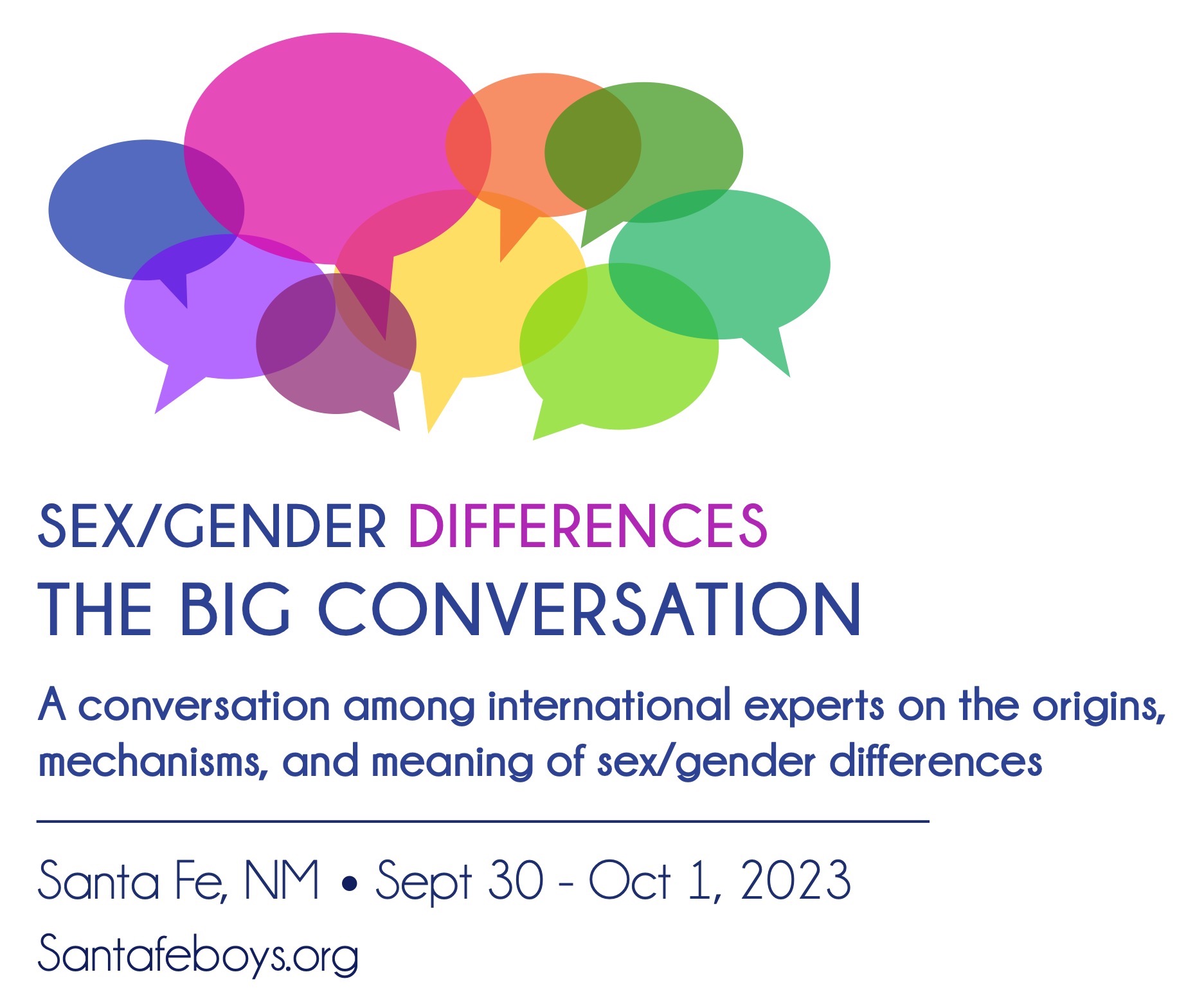
Recordings of The Big Conversation
Learn more about The Big Conversation by clicking the links below:
-Participants in The Big Conversation: Bios and Abstracts of Their Presentations
-Format, Program, & Bibliography for The Big Conversation
The entire event is available for viewing on the YouTube channel of the Santa Fe Boys Educational Foundation and can be accessed HERE.
All videos, including individual presentations, can be accessed below.
The Big Conversation consists of:
Three Sessions of
- 5 or 6 individual presentations by the invited scholars (20 minutes for each)
- In-depth discussions among the individual presenters in each session (1 hour).
Two Roundtables
- Designed for a broader discussion. Each one includes eight of the invited scholars (one hour and 20 minutes each).
Introductions to the Big Conversation
Paul Golding, President of the Santa Fe Boys Educational Foundation
Marco Del Giudice, University of Trieste, Italy
Session 1: Individual Presentations (20 minutes)
David Buss
The Denial of Psychological Sex Differences Harms Women
(Presentation Delivered by William Costello)
Session 1: Discussion (1 hour)
Donna Maney, PhD, Emory University
David Geary, PhD, University of Missouri
Cordelia Fine, PhD, University of Melbourne, Australia
David Schmitt, PhD, Kansas State University
David Buss, PhD University of Texas (presentation delivered by William Costello)
Moderator: Paul Golding, President, Santa Fe Boys Educational Foundation
Session 2: Individual Presentations (20 minutes)
Session 2: Discussion (1 hour)
Gina Rippon, Phd, Aston University, UK
Joyce Endendijk, PhD, Utrecht University, the Netherlands
Tania Reynolds, PhD, University of New Mexico
Lise Eliot, PhD, Chicago Medical School of Rosalind Franklin University
Maryanne Fisher, PhD, Saint Mary’s University, Halifax, Canada & the Kinsey Institute
Wang Ivy Wong, PhD, Chinese University of Hong Kong
Moderator: Marco Del Giudice, PhD, University of Trieste, Italy
Session 3: Individual Presentations (20 minutes)
Session 3: Discussion (1 hour)
Margaret McCarthy, PhD, University of Maryland School of Medicine
Daphna Joel, PhD, Tel Aviv University, Israel
Marco Del Giudice, PhD, University of Trieste, Italy
Carole Hooven, PhD, American Enterprise Institute
David Puts, PhD, Pennsylvania State University
Moderator: Gina Rippon, PhD, Aston University, UK
Roundtable 1: Discussion (1 hour 20 minutes)
Margaret McCarthy, Ivy Wong, Marco Del Giudice, Cordelia Fine, David Puts, Lise Eliot, Tania Reynolds, Donna Maney
Moderator: Scott Kaufman
Roundtable 2: Discussion (1 hour 20 minutes)
Daphna Joel, Maryanne Fisher, Joyce Endendijk, David Geary, Gina Rippon, David Schmitt, William Costello, Carole Hooven
Moderator: Scott Kaufman

Paul Golding, PhD
President of the Santa Fe Boys Educational Foundation

Marco Del Giudice, PhD
University of Trieste
Learn more about The Big Conversation by clicking the links below:
-Why The Big Conversation
-Participants in The Big Conversation: Bios and Abstracts of Their Presentations
-Format, Program & Bibliography for The Big Conversation
-How to Attend The Big Conversation
-CEUs
Abstract for David Buss, PhD
The Denial of Psychological Sex Differences Harms Women
David M. Buss, PhD
Evolved psychological sex differences tend to be highly localized in domains in which the sexes have faced recurrently different adaptative challenges over human evolutionary history. Sex differences fall heavily within the domains of sexuality and mating, broadly conceived. These correspond closely to basic sex differences in reproductive biology, such as internal female fertilization, obligatory parental investment, lactation, lifespan fertility curves, and reproductive variances. The corresponding psychological sex differences tend to be large, highly replicable, and cross-culturally and cross-temporally robust. I argue that denial of these empirical realities harms women. I illustrate these harms by discussing sex-biased laws pertaining to sexual harassment, intimate partner violence, stalking, and rape—sex-linked crimes for which men are overwhelmingly perpetrators and women overwhelmingly victims.
Abstract for Marco Del Giudice, PhD
Sex Differences in Brain Size: What Do They Mean?
Marco Del Giudice, PhD
The most conspicuous and robust sex difference in brain anatomy is that males have larger brains than females (about 11% in volume)—substantially larger than one would expect based on the average body size of the two sexes. In recent years, researchers have mainly focused on methods to statistically correct for this difference; notably, the prediction of a person’s sex from brain scans becomes much less accurate when total volume is properly controlled for. However, this approach sidesteps two key questions: do sex differences in brain size have any implications for sex differences in cognition? And why did men evolve disproportionately larger brains to begin with? In this talk, I show that that the sex differences in IQ found in several recent studies are entirely consistent with the observed differences in brain and body size. I then present a novel hypothesis on the evolution of sex differences in brain size, based on evidence that a larger brain increases resilience against brain injury (“brain reserve”) and that men are dramatically more exposed to risk of brain damage. Accordingly, men show systematically better outcomes after Traumatic Brain Injury, as well as lower vulnerability to Alzheimer’s disease. Sex differences in brain size are not just a statistical nuisance, but a fascinating phenomenon that we should strive to understand.
Abstract for Donna Maney, PhD
What Is a Sex Difference?
Donna Maney, PhD
Of the myriad ways humans categorize each other, by far the most prevalent is by sex. Binary sex categories are used not only for the purposes of taking census and ensuring representation, but also for targeting educational interventions and medical treatments. All these uses of sex as a category demand an evidence-based understanding of exactly how the sexes differ and the extent to which those differences matter in the context at hand. In this talk, I will explore the meaning of the term “sex difference.” First, I will discuss how sex is typically operationalized for the purposes of psychological and biomedical research. Second, I will evaluate the analytical approaches by which researchers typically test for sex differences and the findings that are typically used as evidence for them. Finally, I will consider the extent to which those ‘differences’ should and do contribute to public policy and to our understanding of human diversity.
Abstract for Joyce Endendijk, PhD
Why Boys and Men Don’t Care About Caring?
Joyce Endendijk, PhD
The past decades important progress towards more occupational gender equality has been achieved worldwide by increasing women’s representation in science, technology, engineering, and mathematics. Yet, true equality has not been reached as men are still clearly underrepresented in communal roles in health care, education, and the family. Roots of gender inequality in communal roles are already visible in middle childhood, with boys desiring to become a police officer or fire fighter, and girls desiring to be a teacher, nurse or mother. Several socialization processes in the family and school context might contribute to boys and men’s lesser interest and engagement with communal roles, such as exposure to gender role models, gender segregation between peers, and differential treatment of boys and girls. Yet, it might also be important to consider evolutionary processes related to parental investment to fully understand why boys and men care less about caring than girls and women.
Abstract for Lise Eliot, PhD
How Gender Grows in the Brain
Lise Elliot, PhD
Gender gaps are present across human experience and have long been assumed to be a product of brain evolution. As a neurobiologist schooled in sexual dimorphism, I set out to explore the basis of gender differences in children, but eventually realized they can’t be found in brain anatomy. Even adult brains differ surprisingly little by sex, once overall size is accounted for. Nor have studies comparing trans- and cis-gender participants identified reliable neural signatures of gender identity. Where, then, do group-level gender differences come from? Based on our broader understanding of brain development, along with a more fluid, non-binary conception of gender, its development can be envisioned as an early, dynamic shaping of neural circuits that attune an individual’s temperament to the prevailing sociocultural environment. Appreciating this neuroplasticity is important for addressing gender gaps and has already benefited girls’ academic and athletic achievement. Boys, however, have not had the same latitude, due to the cost of appearing “girly.”
Abstract for Joyce Endendijk, PhD
Why Boys and Men Don’t Care About Caring?
Joyce Endendijk, PhD
The past decades important progress towards more occupational gender equality has been achieved worldwide by increasing women’s representation in science, technology, engineering, and mathematics. Yet, true equality has not been reached as men are still clearly underrepresented in communal roles in health care, education, and the family. Roots of gender inequality in communal roles are already visible in middle childhood, with boys desiring to become a police officer or fire fighter, and girls desiring to be a teacher, nurse or mother. Several socialization processes in the family and school context might contribute to boys and men’s lesser interest and engagement with communal roles, such as exposure to gender role models, gender segregation between peers, and differential treatment of boys and girls. Yet, it might also be important to consider evolutionary processes related to parental investment to fully understand why boys and men care less about caring than girls and women.
Abstract for Cordelia Fine, PhD
The Evolved Gender Constructivist?
Cordelia Fine, PhD
This talk will defend the viability of a social constructivist account of sex differences in behaviour – not as an alternative to an evolutionary account, but as an evolutionary account. I will start with sex, and an explanation of sex differences in mating behaviours in terms of a sexual cascade of evolutionary innovations. In our own species, this evolutionary innovation took the form of sociocognitive capacities and culturally scaffolded environments that enable hyper-cooperation, including socialized specialization into social roles. Does this include gender roles? I’ll briefly address three objections: that it is a theoretical impossibility; evidence from clinical populations with disruptions to early gonadal hormones; and so-called gender equality paradox findings.
Abstract for Maryanne L. Fisher, PhD
Unraveling the Intricacies of Women’s Mating Competition
Maryanne L. Fisher, PhD
Rivalry among individuals of the same sex for access to mates is an integral part of sexual selection theory, with significant research dedicated to understanding its dynamics and implications. Women’s intrasexual competition has traditionally been considered less overt than men’s, characterized by complex social maneuverings rather than physical confrontations. Notwithstanding this, it is no less intense or influential in shaping human behavior and societal norms. The existing literature suggests that hormonal differences, individual personality traits, cultural contexts, and environmental factors all play a role in modulating this competition. However, the extent and interplay of these factors are not fully comprehended and warrant further investigation. Instances of relational aggression, such as gossip and ostracism, and more severe manifestations like sexual coercion, raise pertinent questions about the costs of this competition. These aspects underscore the need for a comprehensive understanding of the phenomenon, encompassing not just the evolutionary advantages but also the potential drawbacks. Future researchers must aim to unravel the intricate balance between biological predispositions and socio-cultural influences; how inherent, evolutionary drives for competition among women are affected by, or interact with, societal norms, expectations, and cultural differences.
Abstract for David C. Geary, PhD
Evolution, Nurture, and Variation in the Magnitude of Human Sex Differences
David C. Geary, PhD
Sex differences that have a biological basis to them are not fixed, genetically determined differences. These differences are often found for traits that influence competition for mates or mate choices and their magnitude is influenced by social and ecological conditions. Sex differences are larger for populations living in favorable conditions and shrink for populations living in less favorable ones. The pattern will be illustrated by linking the magnitude of sex differences to the Flynn effect, that is, increases in cognitive performance across the 20th century. These increases are related to better living conditions and appear to be associated with larger sex differences in various physical and cognitive traits. Cross-generational increases in men’s advantage in height are well documented in nations experiencing a Flynn effect and vary with cross-national differences in population health. Although less definitive, similar patterns are found for men’s advantages in spatial abilities and women’s advantageous in language and memory abilities. The basic approach will be outlined, and related evidence presented.
Abstract for Carol Hooven, PhD
Testosterone Is the Key to Large and Consistent Sex Differences in Human Behavior
Carol Hooven, PhD
Sex differences such as those in aggression and libido originate primarily from differences in genes and hormones, shaped by evolution. Only male mammals possess a Y chromosome, leading to testes and sperm rather than ovaries and eggs. High testosterone coordinates the development and expression of the physical and behavioral traits that benefit the reproductive success of sperm producers—males. Human sex differences are consistent with those in other mammals, and are underpinned by similar biological influences. Culture has a significant influence on the expression of behavioral sex differences, but culture is not the source of these differences, nor will it erase them completely. Understanding and acknowledging the strong influence of inherited biology on human sex differences will help us to leverage culture to increase human flourishing.
Abstract for Daphna Joel, PhD
Rethinking Sex, Brain, and Gender: Beyond the Binary
Daphna Joel, PhD
The sex binary is not simply one of several competing theories regarding human brain and behavior within science. Rather, it is a taken-for-granted starting point that biases the scientific exploration of the relations between sex and brain and behavior. Using the case of the brain, I will describe how data from animal studies challenge the binary framework and open a new way – the mosaic hypothesis – of thinking about ‘sex itself’ and its relations with brain and behavior. Applying varied analytical methods to the structure of over 5,000 human brains, we found that most brains comprise of unique ‘mosaics’ of both features that are more common in women and features that are more common in men; the brain architectures typical of women are also typical of men; and sex category provides little information on human brain structure.
Abstract for Margaret M. McCarthy, PhD
Sex Differences in the Brain: Entwining of the Endocrine, Immune and Nervous Systems
Margaret M. McCarthy, PhD
Establishing the cellular mechanisms by which neuroanatomical and physiological variations are established in the brain is a fundamental goal of neuroscience. Incorporating sex as a biological variable provides a contrast agent revealing evolutionary influences in parameters directly relevant to reproduction. It has been known for over 50 years that the endocrine system drives distinct developmental processes in specific brain regions that differ in males versus females. Recent years have highlighted a contributing role for immune cells and signaling molecules traditionally associated with inflammation. The partnership of non-neuronal cells with the nervous systems is cemented by direct hormonal modulation of immune cells such as microglia, brain specific macrophages, and mast cells, innate immune cells normally found in the periphery. The combination of neural, endocrine and immune influences creates innumerable nexuses for individual variability that often begin during gestation and early brain maturation but can manifest across the life span.
Abstract for David Puts, PhD
Gender Socialization Is Not Enough: How Sex Hormones Produce Behavioral Sex Differences
David Puts, PhD
How do males and females develop different patterns of behavior when they are almost genetically identical? In laboratory animals, hormones secreted by the gonads produce sex differences in gene expression in the developing brain, but the types of experiments showing this would be unethical in humans. Moreover, some social scientists adopt the theory of gender neutrality, that humans are unlike other animals in that differences in gendered behavior are due entirely or almost entirely to differences in early childhood social environment. The most powerful approach to testing this is to examine behaviors in people who were naturally exposed to early sex hormone levels that are unusually high or low compared to most individuals with the same gender of rearing. I will present new evidence from people with endocrine conditions that contradicts the theory of gender neutrality and clarifies how sex hormones influence the development of the human brain and behavior.
Abstract for Tania Reynolds, PhD
Did Same-sex Peers Magnify Sex Differences?
Tania Reynolds, PhD
Across human history, same-sex peers posed challenges and opportunities for ancestral humans. Some ancestors were more successful in defeating their same-sex rivals for mates or resources and some were more successful in recruiting same-sex allies. However, the nature of these competitions and cooperative opportunities differed across the sexes. Ancestral men often competed in physically violent groups, such as in warfare. These group-based competitions should have shaped male psychology to prefer same-sex allies who would have enhanced the group’s likelihood of success. Although ancestral women were less engaged in these physically violent competitions, they still faced incentives to form cooperative alliances with other women. In this talk, I will review evidence supporting that men and women differ in their preferences for same-sex allies. If these preferences persisted across human history, then some portion of modern-day sex differences might be attributable to differences in same-sex social competition.
Abstract for Gina Rippon, PhD
Mechanisms of Inequality: Gender Gaps and the Need to Belong
Gina Rippon, PhD
Cultural norms that encourage targeted social exclusion are at odds with the human need to belong. Social cognitive neuroscience has identified the brain processes underpinning this potent need, and mapped the negative brain and behavioural consequences when this need is denied.This talk will illustrate these processes by discussing their role in two areas where the consequences of social exclusion (or its anticipation) are evident. The first is the alleged Gender Equality Paradox, where the greatest under-representation of women in science is found in the most gender equal countries. The second takes us into the world of female autism, where damaging camouflaging/masking behaviour can result in misdiagnosis (or missed diagnosis), and is associated with increased rates of both physical and mental harm. The aim is to demonstrate how social and cultural pressures can have a core role in determining negative neural and behavioural outcomes, to the disadvantage of targeted groups.
Abstract for David Schmitt, PhD
How Not to Think about “Evolved” Differences between Women and Men
David Schmitt, PhD
Almost all commonly observable differences between women and men that (might) result from evolutionary forces (e.g., height, voice, grip strength, mental rotation ability) reliably emerge because the evolved mechanisms giving rise their development are designed differently in women and men. Even so, these differences in psychological design do not mean that all women (or all men) everywhere in the world must express evolved traits (gender essentialist thinking). Nor must all women but absolutely no men (or vice versa) express evolved traits (gender-dichotomized or gender binary thinking). Nor must all women (or all men) inevitably express evolved traits regardless of developmental experiences (biologically deterministic thinking). Nor must all women and men express evolved traits to the same exact degree in every culture (cultural-invariance thinking). These “Toxic Tetrad” misunderstandings of evolved sex differences are common, but they should be avoided for proper thinking about evolution and the socioecological generation of gendered psychology.
Abstract for Wang Ivy Wong, PhD
Reflecting on the Variable Perceptions of Gender/Sex Issues
Wang Ivy Wong, PhD
The field of gender and sexuality is loaded with controversies and ever-changing assumptions. In this talk, I will reflect on my research journey in the cross-section of developmental psychology and gender development. In particular, drawing on research on childhood play, spatial and social skills, gender identity and stereotypes, and single-sex schooling, I will deliberate on the changing and variable perceptions of gender/sex issues. Preferences for “nature” and “nurture” explanations and gender labels will be used as illustrative examples. At the same time, I will discuss the salience of gender/sex as an aspect of social cognition and segregation. Lastly, I will also discuss the relative emphasis on gender differences and stereotypes that favor men/boys vs. women/girls. This presentation aims to highlight some of the field’s ongoing big questions, and raise more questions for conversation.

